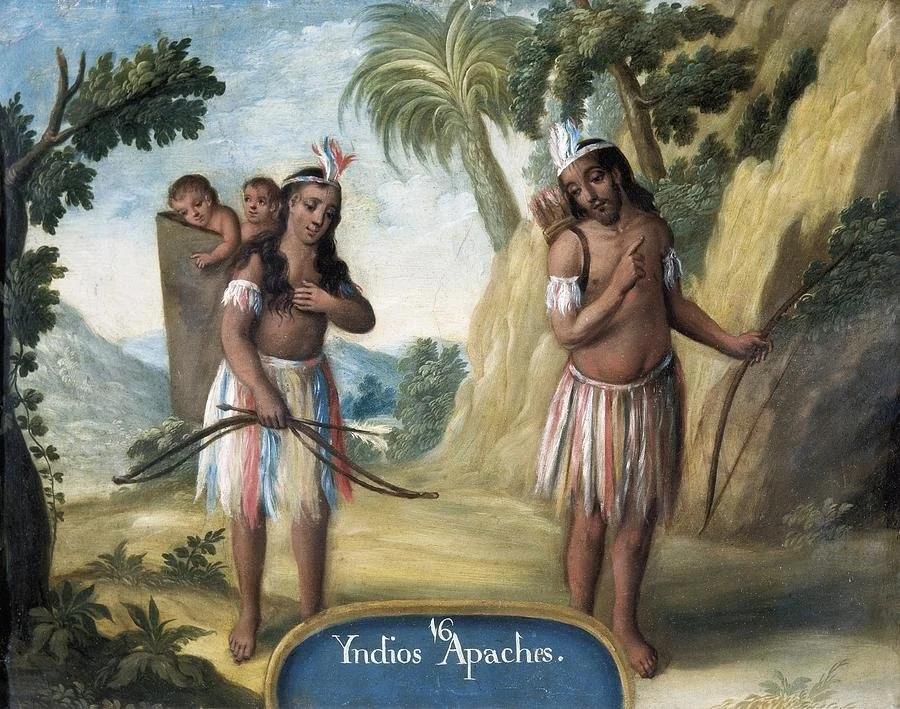Tucson: The First Reservation in the Southwest
The first reservation in what is now the American Southwest was located in today’s Tucson, Arizona.
This partition of land had Apaches as its first residents and began its existence on January 5, 1793. On this day, Ensign Jose Ignacio Moraga, commander of the Spanish Presidio San Agustin de Tucson received the first band of peaceful Apaches into the community for resettlement adjacent to the frontier adobe fortress.
Frontier Spanish Presidio Officers & Soldiers by David Rickman.
The Spanish had initiated a peace policy in 1786 which directly led to this action. The colonial administration saw the financial advantages of transitioning from costly military engagement with the Apaches to extending the olive branch.
In return for laying down arms, the Spanish made it known that free rations of beef, grain, sugar, and tobacco would be provided to the Apaches alongside resettlement near their presidios. These first Apaches who took up this offer on that January day originated from the lands around the juncture of the San Pedro and Gila Rivers and practiced agriculture.
To understand how this all took place, take a look at this primary source record from Sonora’s Spanish military commander describing this important historical happenstance:
Arizpe
January 21, 1793
To COMMANDER GENERAL PEDRO DE NAVA.
On January 6, the commandant of the Tucson presidio, José Ignacio Moraga, informed me that Nautil Nilché, leader of a group of Aravaipa Apaches known as the Vinictinines, and fifteen warriors accompanied by their women and children had trooped into Tucson the day before to settle in peace. Their total number was fifty- one. Nautil Nilché promised Moraga that more of their relatives would appear the next day. On the day of writing, forty-one Aravaipas came into Tucson to join their relatives as predicted.
In keeping with your instruction of October 12, 1791, I am ordering Moraga to give them gifts of raw sugar and outfit their leader with a suit of clothes. I consider this very important, since the peace of the entire Pimería Alta stands to benefit so much from this. In fact, when Moraga sent one of these Apaches to present himself personally to me as an assurance of their alliance, I myself outfitted him with a complete suit of clothes. Their sincerity is further assured by six sets of enemy ears in Moraga's possession, which Nautil Nilché collected personally.
The paymaster of the Tucson presidio, Ensign Agustín Márquez, happens to be here in Arizpe at the present time to collect the company payroll. I have given him further instructions on how to consolidate this peace, so vital to our government and the Spanish province of Sonora. I intend to pay a personal visit to the Tucson presidio within the next few days, so important is this whole matter. I have even taken it upon myself to buy fifty head of cattle, pending government reimbursement at your command, to provision these Aravaipas and convince them that they have chosen a better life.
MANUEL DE ECHEAGARAY
Military Commander of Sonora
Known as an establecimiento de la paz, or peace establishment rather than the U.S. terminology of reservation, the area of this first reservation in the American Southwest roughly corresponds to today’s Barrio Anita in Tucson, located “north of St. Mary's Road between Main Street and the Santa Cruz River.”
92 Apaches made Tucson their home in 1793 and would later be joined by 236 Pinal Apache in 1819.
Do you want to learn more about the deep heritage of Tucson, Arizona? Join us as a companion on our most popular Arizona tour, Tucson’s Origins here.
Sources:
“Barrios in Tucson.” Pima County Public Library. Accessed January 17, 2024. https://www.library.pima.gov/content/barrios-in-tucson/.
McCarty, Kieran. Desert Documentary. Tucson: Arizona Historical Society, 1976.
Sheridan, Thomas E. Los Tucsonenses: The Mexican Community in Tucson, 1854–1941. Tucson: University of Arizona Press, 2016.


